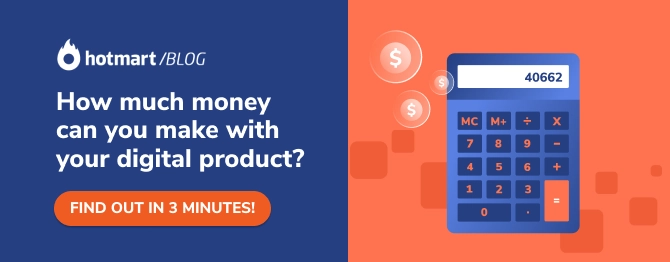
What is ROI and how do you measure it?
One of the most important metrics for entrepreneurs, ROI points out the strategies that achieve the best results. Learn how to accurately measure yours!

What will we see in this post
To improve the performance of your business at a steady pace, you need to separate the strategies that are working from those which aren’t.
ROI (Return on Investment) is one of the best ways to understand how healthy your business is. It reflects the financial return after every action you’ve taken, including your marketing campaigns.
Not sure if you’re making the right investment? Discover what ROI is and learn how to monitor this metric closely!

Definition of ROI
ROI (Return on Investment) is a metric that weighs out the money invested in a business and the amount received in return. It’s frequently used to assess if an investment is worth it from a financial point of view.
In other words, ROI is your way of measuring the overall financial performance of your business by showing how much you lose and how much you make on every dollar you spend.
This way, you can see if your product or service is really making money and if the marketing strategies you use are really delivering the results you hoped for.
How to calculate the ROI
To calculate your ROI, subtract the total amount invested from the net income. Then, divide the result by the amount of the initial investment, as shown in the formula below:

Since ROI is usually expressed as a percentage, you’ll need to multiply the result by 100.
Imagine you have an online course on carpentry, and the amount of money you spend on creating lessons and marketing your course adds up to $1,500.
Then, you start selling your course for $25, and you manage to sell to 140 students, coming to the amount of $3,500.
This would naturally make you feel happy. It looks like you doubled the amount you invested. But it is important to analyze if this profit margin is good enough in the long run and if it really makes sense to quit your day job and try to make a living just selling this course.
If you apply the ROI formula, what you get is this:

Your ROI was 133%! This is an excellent number for someone who’s just starting out!
But let’s add other variables to this same situation. This way, you can have a better understanding of your business numbers.
What if you will only have two launches per year, and the number of people looking for your course decreases over the next few months? In this scenario, is your investment still viable?
It’s probable that you will have to invest the money you got from the sales in additional marketing for your product, to ensure that you maintain your sales numbers.
And during this period, you would have to keep some money for other expenses in your business, or even personal expenses, right?
If you have a solid business plan for your business, your sales will cover everything you have invested in the short-term, and there will be some capital left to improve your product.
That’s why we recommend having a business plan and monitoring your metrics to make sure you are achieving the expected results.
Find out how much money you can make with a digital product
Are you considering creating a digital product? Or maybe expanding your product portfolio? Well, then, it’s essential that you know how profitable your idea is.
Hotmart can help you with that. We have created an exclusive profitability calculator for you. In just three minutes, you can find out how much you could make if you launched the digital product of your dreams — it could be an online course, ebook, or even a webinar.
It is pretty simple: you fill in some information about the digital product you want to launch, including the niche and the size of your audience.
Based on that information and the comprehensive data Hotmart has from more than 580k digital products hosted on the platform and over 35 million users, we can help you estimate your profits, so you can develop the best strategy for you.
Click on the banner below to check it out!
Understanding the components of ROI
ROI is essentially used to find the profitability of a business. It shows the relationship between the amount invested and the profit margin achieved with each sale, as we explained before.
But it can also be applied to calculate and understand the return on each separate investment you make, such as your investment in marketing.
You might be wondering, “But if I already know the total profit from my investment, why would I need to identify the amount achieved separately?”
The answer to this question is simple: to optimize what you’re doing and get results that are even better!
In the case of marketing, when you know the ROI for your campaigns, you can identify which one performs better.
With these results in hand, you can:
- Stop the campaign with the worst performance;
- Change elements such as the Call-to-Action, copy, and images, and see which version achieves better results (always remembering to test one element at a time to isolate a significant variable);
- Invest more money in the campaigns with a higher conversion rate.
Besides campaigns, other marketing channels should be monitored closely to find out if your efforts are achieving results. Things like email marketing, social media, blogs, a customer success team, etc.
ROI and marketing campaigns
To calculate the ROI from marketing, you should break down the income in three different ways:
- Income generated by regular product sales.
- Income generated by sales made through special campaigns.
- Profit, which is the difference between the income minus the costs to create your campaign.
A simple formula would be:

Marketing investment is the total amount spent to air the campaign, such as:
- Costs with creative team.
- Amount invested in paid media.
- Amount spent on marketing automation services.
- Development of Sales Pages, etc.
To illustrate this topic, let’s use the example of the carpentry course again.
Suppose that, to promote your product, you created two Facebook campaigns, investing exactly the same amount of money and scheduling both campaigns to run for the same amount of time.
In campaign number 1, you had a conversion rate of 25%, whereas in campaign number 2, the conversion rate was 12%.
If the total amount of sales made was $3,500, the campaigns generated $875 and $420, respectively.
Since you spent the same amount on each campaign, it’s clear that the first campaign had a much better performance.
However, if more money had been spent in the first campaign, its ROI would have been lower, even though it generated a higher sales volume.
What about another example
The same carpentry course generated $25,000 in sales, but you spent $5,000 on a campaign that achieved a 30% conversion rate.
The 30% of sales generated by your campaign is $7,500. If we apply the formula of the return on investment, it will look like this:

But, in the second campaign, $2,000 was spent to create a landing page. This landing page had a conversion rate of 22% or $5,500 of the total amount generated by your sales.

You can see that the ROI from the second campaign was much better.
Understanding your ROI
Now that you’ve learned how to calculate ROI, it is important to understand what these numbers mean to optimize what you do.
Let’s suppose an ad has a high click and view rate but low conversion.
What does that tell us? Maybe the landing page for that ad was bad. Maybe the Call-to-Action was not persuasive enough. Or maybe the visitors didn’t see anything of interest there.
The failure may also be in the campaign segmentation, which is sending unqualified leads to your sales page. Leads that aren’t ready to purchase.
Whatever the reason for the poor campaign performance, you’ll need to run a few tests until the ad piques the interest of your buyer persona and is more compatible with your offer.
Conclusion: calculating the ROI to determine if your campaign is effective is not enough.
There are many variables that influence the performance of a group of ads, and, in some cases, a simple change in the Landing Page to improve conversion rates is enough.
Why should you measure the ROI for your business?
ROI is one of the best ways to see how healthy your business is.
Through a careful analysis of this data, you can identify the main sources of income in your business, the most efficient communication channels to promote your product, and if the performance of your marketing campaigns is going according to plan.
Only then will you be able to develop strategies that will continuously improve your sales and make sure your business venture is sustainable.
If you want a detailed analysis of your ROI, it is important to differentiate the metrics that genuinely strengthen your business from vanity metrics. Vanity metrics are the ones that bring visibility but don’t convert in terms of leads and sales.
For instance, an increase in the traffic to your blog can indicate that the content published there is attracting more visitors. But to calculate your ROI, the number that really matters is how many of these visitors actually become leads, sign up for your newsletter, or buy your product.
That doesn’t mean that you shouldn’t worry about increasing the traffic for your blog or getting more Facebook followers. These are important numbers for you to become an authority in your segment.
But to have a relevant metric, you have to turn this traffic into leads, leads into sales, and customers into fans of your brand.
Beyond ROI, there are other metrics that you need to follow if you want to know how healthy your business is.
Want to know what these metrics are?
Check out this post with 9 metrics every creator should keep their eye on.
This post was initially made in May 2017 and later updated to provide more accurate information.





